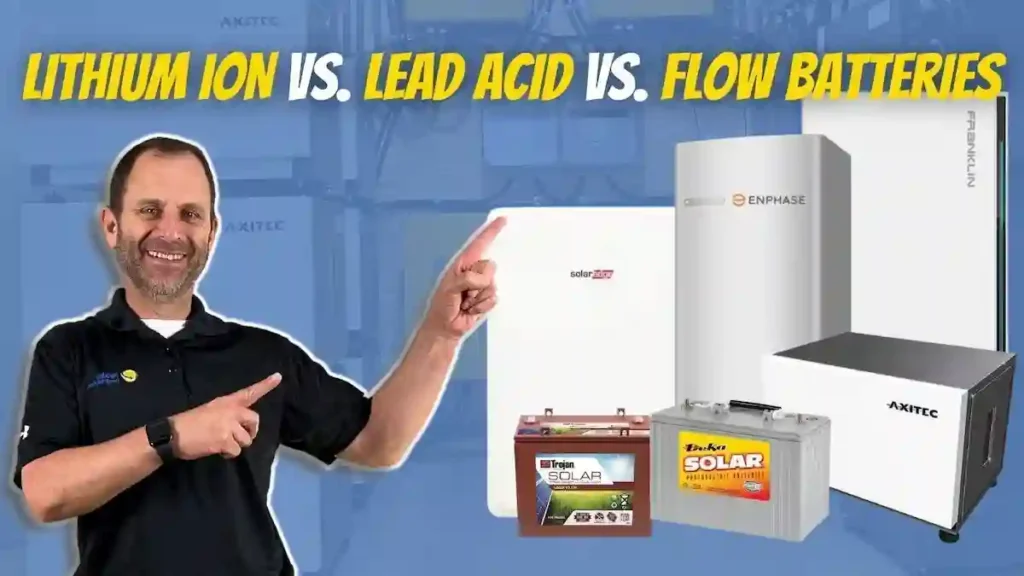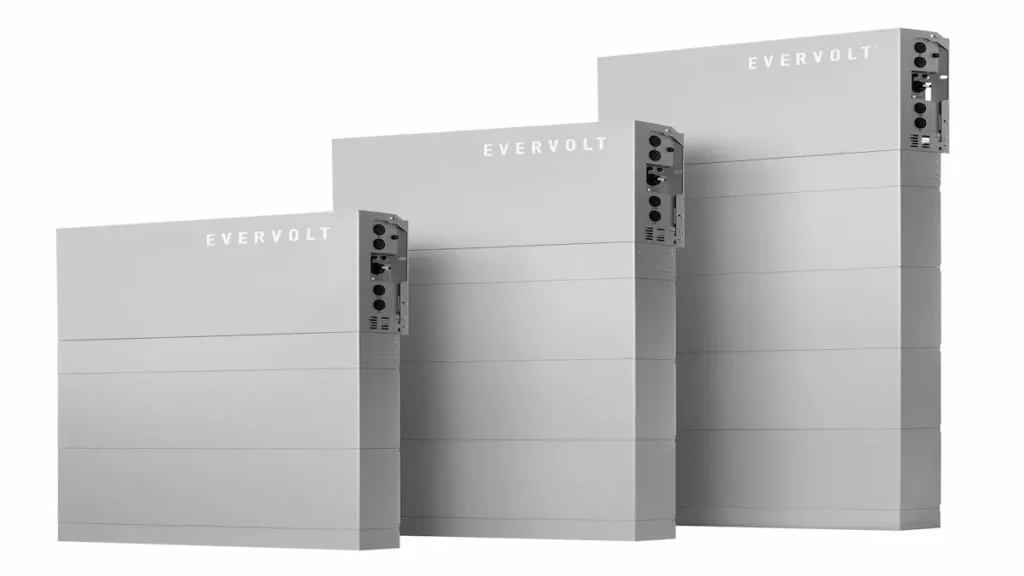Image Source: Panasonic,
With our energy-conscious era today, lithium battery bank for solar or solar battery bank batteries have become a necessity for outdoor users as well as homeowners. They store solar energy for future use when sunlight ceases to be a reliable source of energy. Here, we discuss various solar battery bank batteries, how long they last, how much they cost, and how to pick out one that best suits your needs. There are many factors to take into consideration when shopping for solar batteries for your home solar power system. Two things to keep in mind are the type of battery you’re looking for and what exactly you want to get out of your battery.
There are four types of solar batteries: lead-acid, lithium-ion, nickel cadmium, and flow batteries. The most popular home solar batteries are lithium-ion. Lithium-ion batteries can come as AC or DC coupled. AC-coupled batteries can be connected to existing solar panel systems, while DC-coupled batteries are most suited for being installed at the same time as solar panels.
Related Posts
Deka Battery, 21700 Battery & 3 Volt Battery Guide: What to Know Before You Buy
Different Types of Solar Batteries and How to Choose the Best One (2025 Guide)
Top 5 Deep Cycle Marine Battery for Off-Grid Solar Systems (2025 Reviews)
The Best 12V 280Ah LiFePO4 Batteries for Campers, RVs, and Backup Power
Best Rechargeable Batteries: Why Bluetti Keeps Leading Off-Grid Solar
Buy 10kW Solar Batteries with Warranty and Quick Delivery Across Australia
What Is a Lithium Battery Bank for Solar?
A lithium battery bank for solar is a storage system made up of lithium-ion batteries that stores energy produced by solar panels. Instead of sending all your solar power back to the grid or wasting excess energy, a battery bank lets you save that electricity for later—like at night, during power outages, or on cloudy days.
Lithium batteries are quickly becoming the top choice for solar energy systems because they’re more efficient, longer-lasting, and more compact than traditional lead-acid batteries. They also charge faster, hold their charge longer, and require virtually no maintenance.
If you live off-grid, or you want to maximize your solar investment and reduce reliance on your utility company, a lithium battery bank is a smart upgrade. Paired with the right solar inverter and charge controller, it can power everything from your lights and appliances to larger systems like air conditioning or EV chargers.
What are Solar Battery Bank Batteries?
Battery banks for solar batteries are batteries that are designed to store power from solar panels. They allow you to use solar energy when sunshine isn’t available, for instance, at night time or during cloudy weather. They are crucial for use in off-grid living, backup power during emergencies, and reducing reliance on traditional power grids.
Solar Battery, lithium battery bank for solar Types

Image credit to Paradise energy
It is crucial to know about different types of solar battery bank batteries while choosing a suitable system:
- Lithium batteries are renowned for their high energy density, long life, and low maintenance. They are light in weight but have a greater depth of discharge than other batteries.
- Lead-Acid Batteries: They are cheaper in cost but are an old technology requiring upkeep and having a shorter lifespan.
- Nickel-Based Batteries: Less recognized but offer a long life span and can operate within a broad temperature spectrum.
- Flow Batteries: These are suitable for big applications, with a long lifespan, and can be recharged numerous times without losing capacity.
Each of these battery backup power technologies has its own set of unique characteristics, making them best for different types of solar systems. Let’s still take a deep look at what each type of solar battery has to offer.
Lithium-ion batteries
Lithium ion batteries are the new kids on the energy storage block.
As the popularity of electric vehicles began to rise, EV manufacturers realized lithium ion’s potential as an energy storage solution. They quickly became one of the most widely used solar battery banks.
One of the biggest disadvantages of lithium ion batteries is that they are more expensive than other energy storage technologies. The Tesla Powerwall costs about $16,000 and is one of the cheapest options available!
Best for: Lithium ion batteries are best for residential solar installations because they can hold more power in a limited space, and allow you to use more of the energy stored within the battery, which is great for powering a home.
Pros
Require little maintenance
High energy density
Longer lifespan
Cons
High upfront costs
Increase chance of thermal runaway if installed poorly
Lead acid batteries
Lead acid batteries are the tried and true technology of the solar battery world.
These deep-cycle batteries have been used to store energy for a long time – since the 1800’s, in fact. And they’ve been able to stick around because of their reliability.
There are two main types of lead acid batteries: flooded lead acid batteries and sealed lead acid batteries.
Best for: The reliability of lead-acid batteries is great for off-grid solar systems, or for emergency backup storage in case of a power outage.
Pros
Cheap
Reliable
Easy recycling and disposal
Cons
Require regular maintenance
Installation limitations
Short lifespan
Nickel cadmium batteries
Nickel cadmium (Ni-Cd) batteries aren’t as widely used as lead acid or lithium ion batteries.
Ni-Cd batteries first sprung on the scene in the late 1800’s, but they got a makeover in the 1980s that greatly increased how much energy they could store. They are a favorite amongst the aircraft industry.
Best for: Ni-Cd batteries are popular for large scale applications, like utility solar energy storage, because of their durability.
Pros
Durable
Operate at extreme temperatures
Little maintenance
Don’t require complex battery management system
Cons
Cadmium is extremely toxic
Prone to the memory effect, which limits ability to hold a charge
Flow batteries
Flow batteries are an emerging technology in the energy storage sector.
They contain a water-based electrolyte liquid that flows between two separate chambers, or tanks, within the battery. When charged, chemical reactions occur which allow the energy to be stored and subsequently discharged. These batteries are now beginning to rise in popularity.
Their larger size makes them more expensive than the other battery types. The high price, combined with the large size, makes it hard to adapt them to residential use. However, redflow manufacturers a residential flow battery, which they call ZCell.
Best for: Flow batteries are best for large-scale installations.
Pros
100% depth of discharge
30 year lifespan
Minimal fire risk
Cons
Very expensive
Low storage capacity
Low charge and discharge rates
Require a lot of space
| Battery Type | Lifespan (Years) | Maintenance | Cost Range (USD) | Ideal Use Case |
|---|---|---|---|---|
| Lithium-Ion | 10-15 | Low | $5,000 - $18,000 | Home energy storage |
| Lead-Acid | 3-7 | High | $1,000 - $5,000 | Budget-friendly setups |
| Nickel-Based | Up to 15 | Medium | Varies | Industrial applications |
| Flow Batteries | 20+ | Low | $20,000+ | Large-scale energy storage |
Battery prices for a solar battery bank are determined by type, capacity, and manufacturer:
Lithium-Ion: Varies between $2,000 and $18,000, based on capacity and make.
Lead-Acid: Less expensive, ranging from $600 to $1,000.
Nickel-Based: Prices vary widely but are generally higher due to durability.
Flow Batteries: Can be very expensive, up to more than $25,000, yet long-lasting.
It isn’t merely the initial cost one must consider, but also the cost of ownership in terms of replacements and maintenance.
Solar Battery Charger Power Bank
A solar battery power bank combines solar panels with battery backup. It is best utilized for powering small gadgets like phones, cameras, and tablet PCs, especially for outdoor uses or during a power outage. They are lightweight, compact, and provide a constant power supply when you are not connected to a grid.
When shopping for a solar battery charger power bank, consider capacity (measured in terms of mAh), charging speed, construction quality, and how many ports are available. Some solar battery chargers have additional features like water resistance, flashlights, and wireless charging.
The Right Battery Choice for Your Needs
Selecting the correct solar battery bank battery requires taking several factors into consideration:
Energy Needs: Assess your daily energy use to determine your battery capacity requirements.
Budgeting: Compare upfront payments with long-term upkeep expenses and savings.
Space Considerations: Make sure you have enough space to accommodate installations, especially for large battery systems.
Patterns of Use: Consider how often you’ll be tapping your stored energy reserves, and at what moments.
Consulting a solar energy expert can provide you with personalized advice based upon your unique circumstances.
Most Frequently Asked Questions
What is a lithium battery bank for solar?
A lithium battery bank for solar is a collection of lithium-ion batteries designed to store energy generated from solar panels. This allows you to use stored solar power at night, during outages, or when sunlight is limited—maximizing your system’s efficiency and energy independence.
How is a solar battery bank different from a solar battery charger power bank?
A solar battery for a business or a household refers to a large energy storage unit, holding energy from solar panels for later use. A solar battery charger power bank, by contrast, refers to a power pack to charge small appliances, where solar panels are linked with battery backup in a portable pack.
How often should I service my solar battery bank batteries?
Frequency of servicing varies with battery type. Lead-acid batteries need occasional checks for levels of electrolyte and cleanliness at terminals. Flow batteries and lithium-ion are low-maintenance ones but need occasional checking for peak performance.
Will a 12V solar battery charger suit my vehicle?
A solar battery charger at 12V can be utilized to charge automobile batteries. It’s useful especially for maintaining batteries in cars that are not frequently used.
How do lithium solar batteries differ from lead-acid batteries?
The solar batteries made from lithium are longer-lasting, more energy-dense, require minimal servicing compared to lead-acid batteries, yet are pricier at purchase.
It ultimately comes down to your specific requirements and your budget. Buying quality solar battery bank batteries can significantly boost your energy self-sufficiency and reduce your reliance on traditional sources. With knowledge of types, lifespan, and cost, you are able to make informed decisions suitable for your energy requirements and your budget.
Author
Top Solar Picks, founded by John, a Solar Energy Writer and Researcher with over 12 years of experience in renewable energy, is dedicated to helping homeowners and businesses make informed, data-driven decisions about solar power. John’s expertise and research pr...

